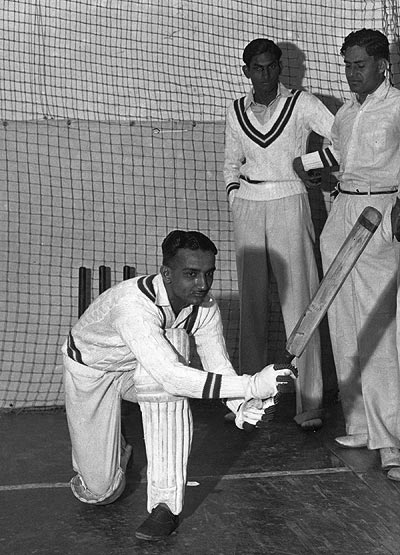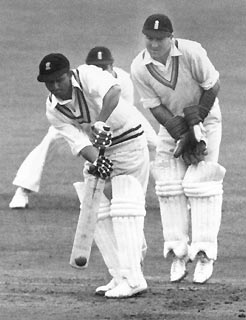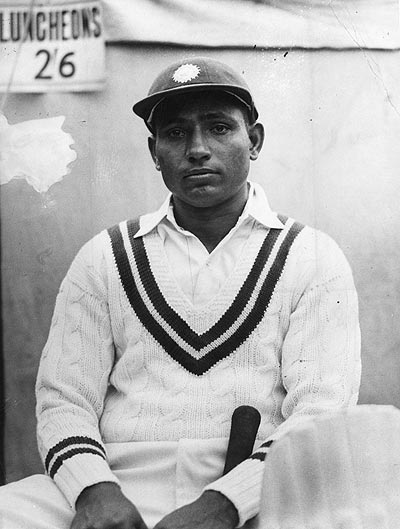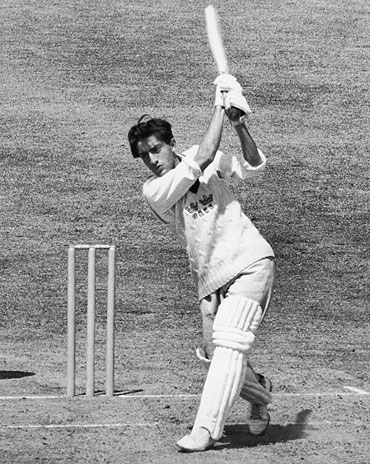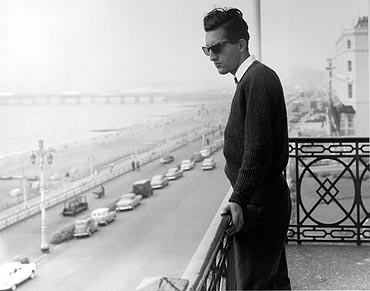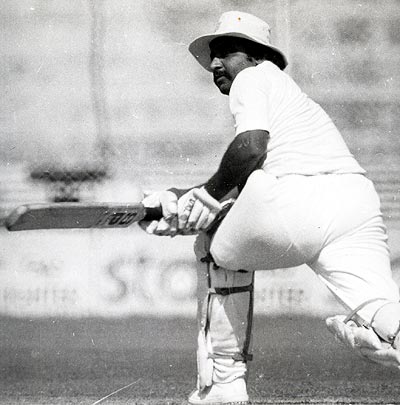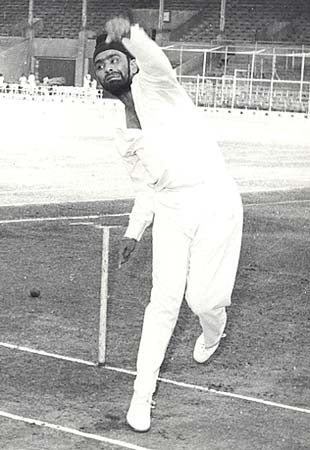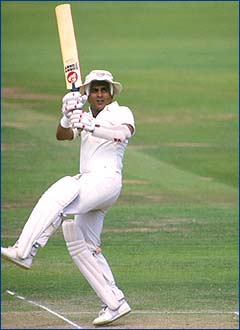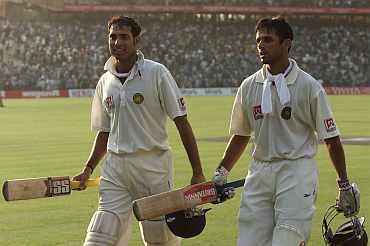 | « Back to article | Print this article |
India-Australia cricket ties: Some interesting facts
Ahead of the Test series commencing Down Under on Boxing Day, Haresh Pandya looks back on cricket contests between the two countries.
Indo-Oz cricket relations date back to 1945-46 when the star-studded Australian Services team visited India following a series of "Victory Tests" in England. Captained by Lindsay Hassett, the side included other notable players in mercurial all-rounder Keith Miller and Cecil Pepper.
Led by Vijay Merchant, the Indian team featured players like Vinoo Mankad, Lala Amarnath, Vijay Hazare, Aamir Elahi, Rusi Modi and Dattu Phadkar.
Besides playing three unofficial Tests, the Aussies played against a Prince's XI and three zonal teams.
Merchant offered glimpses of his class to the visitors by scoring a polished 77 against them for West Zone at Mumbai. Modi essayed a grand innings of 168 while Hazare and Phadkar scored 73 and 71 not out respectively. But it was Miller who stole the thunder with an enchanting, enterprising 106.
Merchant invites the wrath of all by resorting to questionable tactics
Australia would have won the first Test in Mumbai but for want of time. The hosts were forced to follow-on after having scored 339 in response to Australia's 531. India made 304 in the second innings and set Australia an impossible target of 113 runs in 20 minutes.
There was no question of Australia achieving the victory despite Hassett and Miller opening the innings for a change and going after the bowlers. Yet, the Indian captain, possibly fearing that Australia might just make it, resorted to questionable tactics by placing eight players on the boundary and instructing medium-pacers Hazare, who bowled Hassett for 11, and Amarnath to bowl outside the leg-stump.
Merchant invited the wrath of all, including Kumar Shri Duleepsinhji, the chairman of selectors. Although India drew the second Test in Kolkata (Merchant run out 12 and 155 not out) and won the third in Chennai by 6 wickets, and with it the series as well, he was replaced by Iftikhar Ali Khan, the 8th Nawab of Pataudi, a non-salute princely state, for the subsequent tour of England in 1946.
Amarnath takes the reign from Merchant
Pataudi, who had health problems, was unlikely to captain India after the England tour. Besides, like most princes, he had more important things to handle after the Independence. Merchant was still the best candidate and the selectors appointed him captain for the tour of Australia in 1947-48. But Merchant's old groin injury began to trouble him again, forcing him to withdraw from the tour.
This was not the only blow to the Indian team; Mushtaq Ali, Fazal Mahmood and Modi also dropped out citing different reasons. So Amarnath was pitchforked into the thorny throne to match wits with Don Bradman.
Though Amarnath scored 144, 94 not out and 228 not out in successive innings, and subsequently 172 not out, 171 and 135 in tour games, he could not carry his form in the Test series and made only 140 runs in 10 completed innings.
The unstoppable Bradman
There was, however, some consolation as Amarnath the bowler took 13 wickets (the most by any Indian in the series) at 28.15. Considering the mighty Aussies played just six innings in the five Tests, this was a remarkable performance.
Not surprisingly, Bradman's scores in the series were 185, 13, 132, 127 not out, 201 and 57 (retired hurt) -- 715 runs at 178.75. The juggernaut was simply unstoppable. The only time he fell to a regular bowler was at Melbourne, when he became LBW to Phadkar for 132. On other three occasions he gifted his prize wicket to part-timers. He was hit-wicket to Amarnath for 185 at Brisbane and bowled by Hazare for 13 and 201 at Sydney and Adelaide respectively.
Unlike Amarnath, described by Bradman as a "picturesque player" and "splendid ambassador", Hazare excelled with the bat, scoring 116 and 145 against the rampaging Ray Lindwall and Miller in the fourth Test at Adelaide and 74 in the fifth at Melbourne. Mankad, who otherwise cut a very sorry figure as an opener, essayed brilliant innings of 116 and 111 in the third and fifth Tests respectively -- both at Melbourne.
All-rounder Phadkar, too, scored a sparkling century (123) at Adelaide. Yet, these very batsmen let India down more often than not in the disastrous series, which Australia won 5-0.
Spin-friendly pitch to India's rescue
Australia toured India in 1956-57 and won the first and third Tests by an innings and drew the second in a series marked by our batsmen's collective failure.
When the Richie Benaud-led powerful Australian side toured India again in 1959-60, Amarnath was the chairman of selectors. His assessment of Australian batsmen's traditional weakness against off-spin bowling on a spin-friendly pitch was the telling factor in India's historic triumph in the second Test at Kanpur. Amarnath insisted on inclusion of the otherwise long forgotten Jasu Patel as he was certain the Gujarat offie would make life miserable for the Aussies on a viciously turning Green Park wicket. His clear instructions to captain Gulabrai Ramchand to bowl Patel from the pavilion end to exploit the rough made by left-arm pace bowler Alan Davidson in his follow-through did much to engineer a spectacular batting collapse.
The Aussies again visited India, in 1964-65, for a series of three Tests. Both India and Australia shared the honours, having won a Test each while drawing another. India's young captain "Tiger" Pataudi and leggie Bhagwat Chandrasekhar played stellar roles in our narrow, two-wicket win in the second Test at Mumbai. While Pataudi, who made unbeaten 128 in India's first innings in the opening Test in Chennai, which Australia won by 139 runs, scored 86 and 53, Chandrasekhar took 4 for 50 and 4 for 73.
'Tiger' roars during the difficult tour
It was after 30 years that India toured Australia the second time -- for a four-Test series in 1967-68 under "Tiger". It was a difficult tour. Worse still, the selectors dropped M.L. Jaisimha without rhyme or reason. However, when Chandrasekhar got injured on the tour, they sent Jaisimha, a specialist bat, as his replacement!
Despite being jet-lagged and spending just a day at the nets, Jaisimha essayed two classic innings of 74 and 101 in the crucial third Test at Brisbane and nearly pulled off an improbable victory. India eventually fell agonisingly short by 39 runs.
Earlier, in the second Test at Melbourne, "Tiger" had even the diehard Aussies gasping with his superb 75 and 85, with only one eye and one leg as he had pulled a hamstring, batting at No. 7.
"I'd have been proud to have played some of the shots you did," said Don Bradman, of all people, to an unbelieving Tiger, when he visited the Indian dressing room. In spite of the captain's excellent form, other leading batsmen chipping in with useful contributions on a couple of occasions and Erapalli Prasanna finishing with 25 wickets, India could not stop the hosts from winning all the four Tests.
Viswanath enthralls with his performance
The 1969-70 series in India will always be remembered for the appearance of Gundappa Viswanath on the big stage with a bang. The original Little Master was consumed by Allan Connolly before he opened his account in his maiden Test innings -- at Kanpur. But the touch artist made amends in the second essay and produced a jewel of an innings of 137, which was studded with exactly 25 fours.
Despite Viswanath continuing his good run, and Prasanna and Bishen Singh Bedi bowling exceptionally well, Australia won the five-Test rubber 3-1. At Delhi, where India won by 7 wickets, Bedi and Prasanna took 5 wickets each in Australia's pathetic second innings of 107.
Bedi leads the pack
When India toured down under in 1977-78 under Bedi, most of the leading Australian players -- the Chappell brothers Ian and Greg, Denis Lillee, Rod Marsh, Doug Walters, et al -- had joined Kerry Packer's revolutionary, if not rebellious, World Series Cricket. Only fast bowler Jeff Thomson had been available for national duty.
But the selectors could not risk handing him Australia's captaincy. So they brought back Bob Simpson from wilderness, ten years after he had called it quits, and gave him reins of the national team.
The wily and vastly experienced Simpson instilled a much-needed dose of confidence in his young players, who responded splendidly and the inexperienced Australian team went on to beat the more experienced Indian side 3-2 in a terribly close series. With the series level at 2-2, the fifth Test in Adelaide held a lot of excitement.
India, set an imposing target of 493 in the fourth innings to win the Test and rubber, made a game effort with Mohinder Amarnath (86), Dilip Vengsarkar (78), Viswanath (73) and Syed Kirmarni (51) pulling off almost an impossible win. Australia eventually won by 47 runs after many tense moments in the most thrilling final session on February 3, 1978.
India taste victory under Gavaskar's captaincy
The six-Test 1979-80 series in India, which we won 2-0 under Sunil Gavaskar, saw the emergence of left-arm spinner Dilip Doshi and off-spinner Shivlal Yadav. Australia, led by Kim Hughes, arrived armed with two of their most potent weapons in Rodney Hogg and Alan Hurst, who had formed a lethal and successful fast bowling pair in the late 1970s. But they turned out to be their own poor shadows on the Indian wickets and against our in-form batsmen.
Instead, it was Geoff Dymock who, at the age of 34, bowled manfully and was the most impressive of the Australian bowlers.
There have since been more and fairly regular exchanges of Test series between India and Australia. The last three decades have been marked with a number of gifted batsmen, fast bowlers, spinners and wicketkeepers from both countries shining brightly in such contests with their individual and collective performances -- in India as well as Australia. And a few characters, too, like Merv Hughes, Greg Matthews and Andrew Symonds.
Eden Gardens victory lingers
There have inevitably been many great Test matches -- none more pulsating and romantic than the Tied Test II in Chennai in 1986, which triggered the renaissance of Australian cricket, and the one at Eden Gardens in 2001, when India thrashed Australia in style after being inflicted the follow-on.
The forthcoming four-Test series down under, starting on Boxing Day, also promises high voltage performances, individually as well as collectively, as both Indian and Australian teams boast of several enormously talented and hugely experienced players in their ranks.
